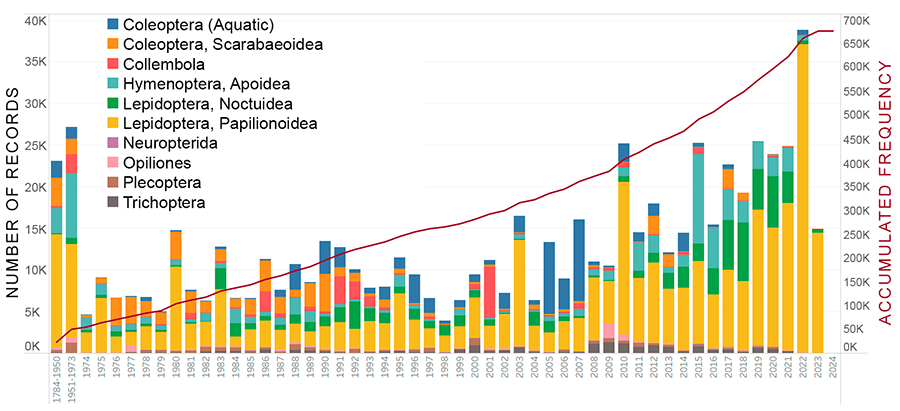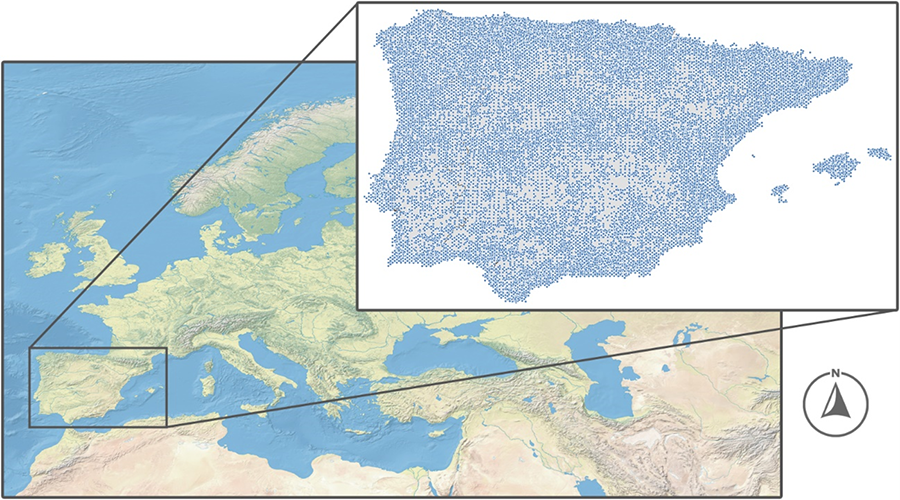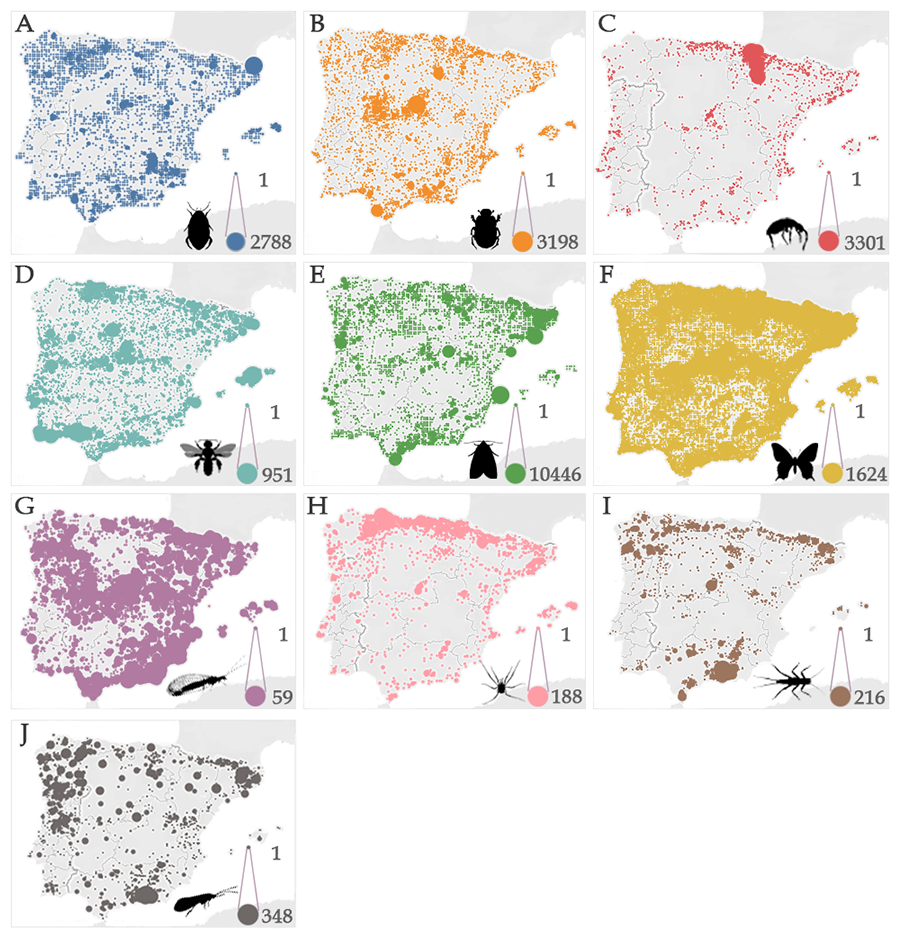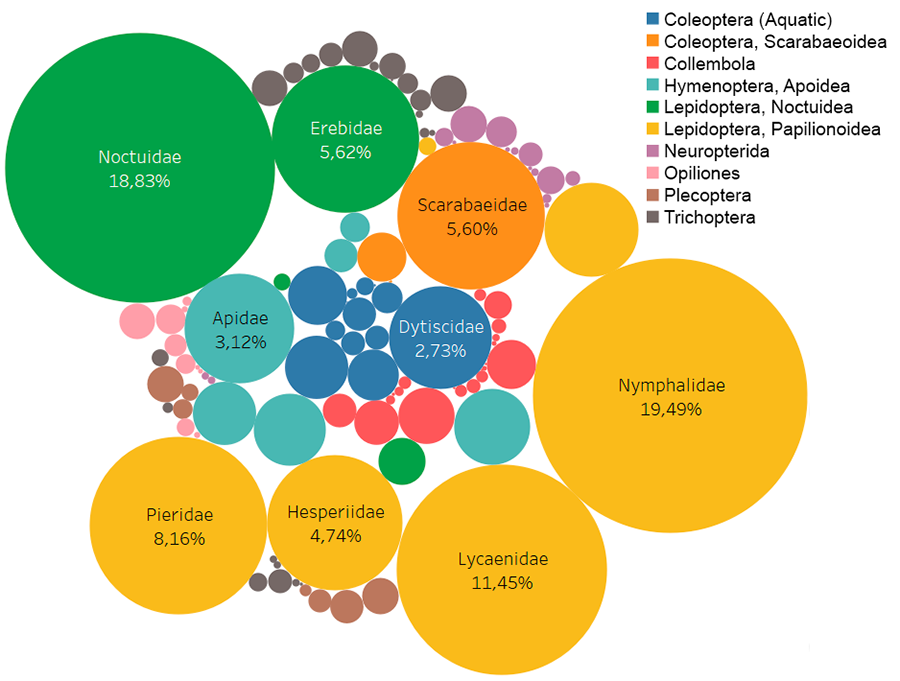|
Name
|
Description
|
|
Id
|
Identifier of the record, unique for
the dataset.
|
|
type
|
The nature or genre of the resource
(Dataset).
|
|
modified
|
The most recent date-time on which the
resource was changed.
|
|
language
|
A language of the resource (es =
Spanish).
|
|
license
|
A legal document giving official
permission to do something with the resource (CC-BY-NC 4.0).
|
|
datasetID
|
A digital identifier for the set of
data (doi:10.15470/pqq9oc).
|
|
institutionCode
|
The name (or acronym) in use by the
institution having custody of the object(s) or information referred to in the
record.
|
|
collectionCode
|
The name, acronym, coden, or initialism
identifying the collection or data set from which the record was derived
(IberArthro).
|
|
datasetName
|
The name identifying the data set from
which the record was derived.
|
|
ownerInstitutionCode
|
The name (or acronym) in use by the
institution having ownership of the object(s) or information referred to in
the record.
|
|
basisOfRecord
|
The specific nature of the data record
(human observation, preserved specimen, occurrence, material citation,
machine observation).
|
|
dynamicProperties
|
Original collection of provenance.
|
|
occurrenceID
|
An identifier for the occurrence (as
opposed to a particular digital record of the occurrence). In the absence of
a persistent global unique identifier, construct one from a combination of
identifiers in the record that will most closely make the occurrenceID
globally unique.
|
|
catalogNumber
|
An identifier (preferably unique) for
the record within the data set or collection.
|
|
recordNumber
|
An identifier given to the occurrence
at the time it was recorded. Often serves as a link between field notes and
an occurrence record, such as a specimen collector's number.
|
|
recordedBy
|
A list (concatenated and separated) of
names of people, groups, or organizations responsible for recording the original
Occurrence. The primary collector or observer, especially one who applies a
personal identifier (recordNumber), should be listed first.
|
|
individualCount
|
The number of individuals present at
the time of the occurrence.
|
|
lifeStage
|
The age class or life stage of the
organism(s) at the time the occurrence was recorded (larva, pupa, imago,
adult).
|
|
occurrenceStatus
|
A list (concatenated and separated) of
identifiers of other occurrence records and their associations to this
occurrence.
|
|
associatedReferences
|
A list (concatenated and separated) of
identifiers (publication, bibliographic reference, global unique identifier,
URI) of literature associated with the occurrence.
|
|
occurrenceRemarks
|
Comments or notes about the occurrence.
|
|
materialSampleID
|
An identifier for the material sample
(as opposed to a particular digital record of the material sample).
|
|
eventDate
|
The date-time or interval during which
an event occurred. For occurrences, this is the date-time when the event was
recorded. Not suitable for a time in a geological context.
|
|
Year
|
The four-digit year in which the event
occurred, according to the Common Era Calendar. (From 1784 to 2024).
|
|
Month
|
The integer month in which the event
occurred.
|
|
Day
|
The integer day of the month on which
the event occurred.
|
|
verbatimEventDate
|
The verbatim original representation of
the date and time information.
|
|
identifiedBy
|
A list (concatenated and separated) of
names of people, groups, or organizations who assigned taxon to the subject.
|
|
habitat
|
A category or description of the
habitat in which the event occurred.
|
|
continent
|
The name of the continent in which the
dcterms:Location occurs.
|
|
country
|
The name of the country or major
administrative unit in which the Location occurs.
|
|
countryCode
|
The standard code for the country in
which the Location occurs.
|
|
stateProvince, county, municipality
|
Name of the smaller administrative
units than country in which the location occurs.
|
|
locality
|
The specific description of the place.
|
|
Mínimum/ maximumElevationInMeters
|
|
|
decimalLatitude
|
The geographic latitude (in decimal
degrees, using the spatial reference system) of the geographic center of a
location. Positive values are north of the Equator; negative values are south
of it. Legal values lie between -90 and 90, inclusive.
|
|
decimalLongitude
|
The geographic longitude (in decimal
degrees, using the spatial reference system) of the geographic center of a
location. Positive values are east of the Greenwich Meridian; negative values
are west of it. Legal
values lie between -180 and 180, inclusive.
|
|
geodeticDatum
|
The ellipsoid, geodetic datum, or
spatial reference system (SRS) upon which the geographic coordinates given in
dwc:decimalLatitude and dwc:decimalLongitude are based.
|
|
coordinateUncertaintyInMetres
|
The horizontal distance (in meters)
from the given decimal latitude and decimal longitude describing the smallest
circle containing the whole of the location. Leave the value empty if the
uncertainty is unknown, cannot be estimated, or is not applicable (because
there are no coordinates). Zero
is not a valid value for this term.
|
|
verbatimCoordinates, verbatimCoordinatesSystem, verbatimSRS
|
The verbatim original spatial
coordinates of the location, Coordinats System and SRS.
|
|
verbatimIdentification
|
A string representing the taxonomic
identification as it appeared in the original record.
|
|
identificationQualifier
|
A brief phrase or a standard term
(“sp.”, “cf.”, “aff.”) to express the determiner's doubts about the identification.
|
|
identifiedBy
|
A list (concatenated and separated) of
names of people, groups, or organizations who assigned taxon to the subject.
|
|
scientificName
|
The full scientific name, with
authorship and date information if known.
|
|
kingdom
|
The full scientific name of the kingdom
in which the taxon is classified.
|
|
phylum
|
The full scientific name of the phylum
or division in which the taxon is classified.
|
|
class
|
The full scientific name of the class
in which the taxon is classified.
|
|
order
|
The full scientific name of the order
in which the taxon is classified.
|
|
family
|
The full scientific name of the family
in which the taxon is classified.
|
|
taxonRank
|
The taxonomic rank of the most specific
name in the scientific name.
|
|
scientificNameAuthorship
|
The authorship information for the
scientific name formatted according to the conventions of the applicable
nomenclatural code.
|
|
taxonRemarks
|
Comments or notes about taxon or name.
|
|
measurementType*
|
maleCount o femaleCount.
|
|
measurementValue*
|
Number of individuals in the record of
each type (male or female).
|
|
measurementUnit*
|
Individual Count.
|
Geographic coverage
Description: The
Iberian Peninsula and Balearic Islands are located in the southwest of Europe (Fig. 1).
This region includes a variety of biomes, climates and landscapes, with
altitudes ranging from sea level to 3483 m a.s.l. in the Sierra Nevada (SE
Iberia). The project includes all available distributional data from the
Iberian Peninsula, including Andorra, Gibraltar (UK), peninsular Spain and
Portugal, and the Balearic Islands (Spain).
Coordinates: 35°23'60"N and 43°58'48"N Latitude; 10°2'24"W and
4°48'36"E Longitude.
Taxonomic coverage
Kingdom: Animalia. Phylum: Arthropoda. Class: Hexapoda and Arachnida
Orders: Coleoptera, Collembola, Hymenoptera, Lepidoptera, Megaloptera,
Neuroptera, Raphidioptera, Opiliones, Plecoptera and Trichoptera.
Temporal coverage
Data range from 1784-08-01 to 2024-02-25.
The earliest records of arthropod occurrences with geolocation information date
back to the late 1700s (De Asso
1784) and correspond to some species of butterflies
and beetles. It was not until 1840 that records of other orders, such as
Hymenoptera (bees) and aquatic Coleoptera, began to appear. The rest of groups
started to have records from 1859 (Plecoptera), 1871 (Noctuoidea, Opiliones,
Scarabeoidea), and 1890 (Collembola and Trichoptera) (Fig. 4). Between 1784 and 1923, the
number of annual of arthropod records in the study area ranged from 1 to 500,
depending on the taxon. However, between 1924 and 1974, this number increased
considerably, ranging between 120 and 4650 records across various taxonomic
groups. From 1975 onward, the annual number of records exceeded 6000 in most
cases, except in 1998, when fewer than 4000 records were recorded. The year
2022 presented a maximum of almost 40 000 records. It should be noted that,
although these databases are kept as up to date as possible, they are subject
to some degree of lag due to the vast amount of information handled and the
constant increase in knowledge sources (Fig. 4).

Figure 4. Number of records and temporal tendency of the accumulated number
of records in the IberArthro database from each taxonomic group.
Figura 4. Número de
registros y tendencia temporal del número acumulado de registros en la base de
datos IberArthro de cada grupo taxonómico.
Records and Data Availability and their
Use
Description: The database has Darwin Core Archive (DwC-A) format, which
includes four files (e.g., occurrences.txt; extendedmeasurementorfact.txt;
eml.xml; and metadata.xml). The main file “ocuurence.txt” contains 1 006 768
records with associated geographic data (at 10 × 10 km grid squares). These
records cover 4612 species and subspecies, spanning from the 18th century to
February 2024. This file is complemented by the extendedmeasurementorfact.txt,
that allows for adding additional information to records when the standard
fields in occurrence.txt are not sufficient, in our case, providing counts of
individuals differentiated by sex.
Format: All data were structured according to
the Darwin Core Standard for Biodiversity (Wieczorek et al. 2012) and published on
the Global Biodiversity Information Facility platform (Mañas-Jordá et al. 2025).
Information about the terms / columns that
make up the dataset can be found in Table 2.
Usage license: This work is licensed under a Creative Commons Attribution
Non-Commercial (CC-BY-NC 4.0) License.
Data package
title: IberArthro: A database compiling
taxonomic and distributional data on Ibero-Balearic arthropods.
Resource link: https://doi.org/10.15470/pqq9oc
Alternative identifiers: https://www.gbif.org/dataset/73319645-c321-48ed-b923- b3782a203589
Data set name: IberArthro: A database compiling taxonomic and distributional data
on Ibero-Balearic arthropods.
Technical Validation
All the data included in our database have
been verified by taxonomists and researchers who are experts in each taxonomic
group. Each taxonomic group has an assigned expert or team responsible for
conducting a thorough validation of each record. In addition, distribution maps
for each species were generated and reviewed multiple times to ensure their
accuracy. The current version uploaded to GBIF (2.4) shows a refined dataset
after two rounds of technical validation and data curation. In general terms, we
used tools and protocols provided by GBIF for evaluating occurrence data
quality (https://www.gbif.org/es/data-quality-requirements-occurrences) The types of technical checks performed during the two rounds of
validation checks for completeness, correctness and consistency to adhere to
the Darwin Core Standard and ensure interoperability. Besides, we used the
Darwin Core Archive Validator tool (http://tools.gbif.org/dwca-validator/) to check whether the dataset meets Darwin Core specifications.
Author´s contribution
SMJ: Wrote the first draft of the paper,
built the maps and tables, coordinated the network of experts who provided data
to compile the dataset, database design, database construction, data
compilation. JLY: Project development, collaborate with specimens’ ID,
collaborated with database construction, data compilation, provided data of
Lepidoptera, Noctuoidea. JML: Project development, collaborate with specimens’
ID, collaborated with database construction, data compilation, provided data of
Coleoptera, Scarabaeoidea. EGR, AJGM: Project development with computing skills
(IT-savvy project development). CP: Collaborated with specimens’ ID, Data
compilation, provided data of Opiliones. VJM: Collaborated with specimens’ ID,
Data compilation, provided data of Neuropterida. AA, DG, EB: Collaborated with
specimens’ ID, Data compilation, provided data of Collembola. IB: Data
compilation provided data of Hymenoptera, Apoidea. AM: Collaborated with
specimens’ ID, Data compilation, provided data of Coleoptera (Aquatic). EGB,
HR, MLM: Collaborated with specimens’ ID, Data compilation, provided data of
Lepidoptera, Papilionoidea. RA, NB, MG, JM, CSC: Collaborated with specimens’
ID, Data compilation, provided data of Trichoptera. MJLR, JMTF, CSC:
Collaborated with specimens’ ID, Data compilation, provided data of Plecoptera.
DSF: Project leader, project design, project development and collaborated with
the writing and revising of the manuscript, collaborated with specimen’s ID,
Data compilation, provided data of Coleoptera (Aquatic).
Financing, required permits, potential
conflicts of interest and acknowledgments
We are grateful to Katia Cezón (Spanish
GBIF node–CSIC) for technical support. We also thank all who provided
unpublished records and bibliographic references to compile the dataset. DS-F
is funded by a postdoctoral contract from the Spanish “Ministerio de Ciencia e
Innovación” (“Ramón y Cajal” program, [RYC2019-027446-I]). This paper has been
conducted within the framework of the Digit_Artro project (TED2021130328B100),
funded by MCIN/AEI /10.13039/501100011033 and by the European Union
NextGenerationEU/ PRTR and supported by the projects Ref. PID2021-124187NB-I00
and 3088153 funded by the Spanish Ministry of Science and Innovation and the
Spanish Ministry for Ecological Transition and the Demographic Challenge –
NextGeneration EU and by the European Union NextGenerationEU, respectively.
The authors declare no conflict of interest.
References
Allsopp, M., De Lange. W., Veldtman, R. 2008. Valuing Insect Pollination
Services with Cost of Replacement. PLoS ONE 3 (9). https://doi.org/10.1371/journal.pone.0003128
Anderson, R., Araújo, M.,
Guisan, A., Lobo, J., Martínez-Meyer, E., Peterson, A., Soberón, J. 2016. Final report of the task group on GBIF data fitness for use in
distribution modelling. Global Biodiversity Information Facility 1‑27.
Barnes, R.S.K., Calow, P., Olive, P.J.W., Golding, D.W., Spicer, J.I.
2009. The Invertebrates A Synthesis. 3rd ed. John Wiley & Sons,
Ltd., Hoboken.
Bartomeus, I., Lanuza, J.,
Wood, T., Carvalheiro, L., Molina, F., Collado, M.Á., Aguado-Martín, L.O., et
al. 2022. Base de datos de abejas ibéricas. Ecosistemas 31(3): 2380 https://doi.org/10.7818/ECOS.2380
Boix, D., Bonada, N., Muñoz, I.,
Baquero, E., Jordana, R., Cunillera-Montcusí, D., Tornero, I., et al. 2024. Class Hexapoda: general introduction. In: Maasri A, Thorp J (Eds) Identification
and ecology of freshwater arthropods in the Mediterranean Basin. 225-281
pp. [ISBN 978-0-12-821844-0]. https://doi.org/10.1016/B978-0-12-821844-0.00019-3
De Asso, I. 1784. Introductio in oryctographiam, et zoologiam Aragoniae.
Accedit Enumeratio stirpium in eadem regione noviter detectarum.
Autopublished, Amsterdam.
Diniz‐Filho, J.A.F., De Marco, Jr
P., Hawkins, B. 2010. Defying the curse of ignorance:
perspectives in insect macroecology and conservation biogeography. Insect
Conservation and Diversity 3(3): 172‑179.
https://doi.org/10.1111/j.1752-4598.2010.00091.x
García-Barros, E.,
Munguira, M., Martín Cano, J., Romo Benito, H., Garcia-Pereira, P., Maravalhas,
E. 2004. Atlas de las mariposas diurnas de la Península Ibérica e islas
Baleares (Lepidoptera:Papilionoidea & Hesperioidea). Vol. 11.
Monografías Sociedad Entomológica Aragonesa, Zaragoza, España. [ISBN
84–932807–5–5].
García-Roselló, E.,
González-Dacosta, J., Lobo, J. 2023. The biased distribution
of existing information on biodiversity hinders its use in conservation, and we
need an integrative approach to act urgently. Biological Conservation
283 https://doi.org/10.1016/j.biocon.
2023.110118
Gullan,
P.J., Cranston, P.S. 2005. The insects: an
outline of entomology. 3rd Edition. Blackwell Pub, Malden, MA. USA.
Gurr, G., Wratten, S., Luna, J.M. 2003. Multi-function agricultural
biodiversity: pest management and other benefits. Basic and Applied Ecology
4(2): 107‑116. https://doi.org/10.1078/1439-1791-00122
Hortal, J. De Bello, F., Diniz-Filho, J., Lewinsohn, T., Lobo, J., Ladle,
R. 2015. Seven shortfalls that beset large-scale knowledge of biodiversity. Annual
Review of Ecology, Evolution, and Systematics 46(1): 523‑549.
https://doi.org/10.1146/annurev-ecolsys-112414-054400
Lobo, J.M. 2020. BANDASCA, BAse
de DAtos sobre SCArabaeidae. Museo Nacional de Ciencias Naturales (CSIC). https://doi.org/10.15468/AYFQIZ
Lomolino, M. 2004. Conservation biogeography. In: Lomolino, M., Heaney, L.
(Eds.), Frontiers of Biogeography: new directions in the geography of nature,
pp 293–296. Sinauer Associates [ISBN 978-0-87893-479-9].
Mañas-Jordá, S., Acosta,
R., Ariño, A., Baquero, E., Bartomeus, I., Bonada, N., Galicia, D., et al.
2025. IberArthro: A database compiling taxonomic and
distributional data on Ibero-Balearic arthropods.
GBIF. https://doi.org/10.15470/pqq9oc
Marcer, A., Haston, E., Groom, Q., Ariño, A., Chapman, A., Bakken, T.,
Braun, P., et al. 2021. Quality issues in georeferencing: From physical
collections to digital data repositories for ecological research. Diversity
and Distributions 27 (3): 564‑567. https://doi.org/10.1111/ddi.13208
Marcer, A., Chapman, A., Wieczorek, J., Xavier Picó, F., Uribe, F., Waller
J., Ariño, A. 2022. Uncertainty matters: ascertaining where specimens in
natural history collections come from and its implications for predicting
species distributions. Ecography 2022 (9). https://doi.org/10.1111/ecog.06025
Martín-Piera, F., Lobo,
J. 2000. Diagnóstico sobre el conocimiento sistemático y biogeográfico de
insectos hiperdiversos (Coleoptera, Hymenoptera y Lepidoptera) en España. In:
Martín-Piera F, Morrone J, Melic A (Eds.), Hacia un proyecto CYTED para el
inventario y estimación de la diversidad entomológica en Iberoamérica: PrIBES
200. 1. Pp. 287-308. m3m-Monografías Tercer Milenio, Sociedad Entomológica
Aragonesa (SEA), Zaragoza, España. [ISBN 84-922495-1-X].
Millán, A., Sánchez-Fernández,
D., Abellán, P., Picazo, F., Carbonell, J.A., Lobo, J.M., Ribera, I. 2014. Atlas
de los coleópteros acuáticos de España peninsular. Ministerio de
Agricultura, Alimentación y Medio Ambiente, Madrid, España.
Monserrat,
V.J., Triviño, V. 2013. Atlas de los
neurópteros de la Península Ibérica e Islas Baleares (Insecta, Neuroptera:
Megaloptera, Raphidioptera, Planipennia) / Atlas of the Iberian and Balearic
lacewings (Insecta, Neuroptera: Megaloptera, Raphidioptera, Planipennia).
13. Sociedad Entomológica Aragonesa (S.E.A.), Zaragoza, España.
Monserrat, V.J. 2022. Los
Neuropterida de la Península Ibérica y Baleares. Boletín de la Sociedad
Entomológica Aragonesa (S.E.A.) 16: 229‑30.
Myers, N., Mittermeier, R.,
Mittermeier, C., Da Fonseca, G.B., Kent, J. 2000. Biodiversity
hotspots for conservation priorities. Nature 403 (6772): 853‑858.
https://doi.org/10.1038/35002501
Pascual, L., Luigi, M., Alessandra, F., Emilio, B., Luigi, B. 2011. Hotspots
of species richness, threat and endemism for terrestrial vertebrates in SW
Europe. Acta Oecologica 37 (5): 399‑412. https://doi.org/10.1016/j.actao.2011.05.004
Samways, M. 2005. Insect diversity conservation. Cambridge
University Press, Cambridge.
Sánchez-Fernández, D., Millán, A., Abellán, P., Picazo, F., Carbonell, J.A., Ribera,
I. 2015. Atlas of Iberian water beetles (ESACIB database). ZooKeys 520:
147‑154. https://doi.org/10.3897/zookeys.520.6048
Sánchez-Fernández, D., Fox, R., Dennis, R.H., Lobo, J. 2021. How complete are insect
inventories? An assessment of the british butterfly database highlighting the
influence of dynamic distribution shifts on sampling completeness. Biodiversity
and Conservation 30 (3): 889‑902.
https://doi.org/10.1007/s10531-021-02122-w
Sánchez‐Fernández, D., Yela, J. L.,
Acosta, R., Bonada, N., García‐Barros,
E., Guisande, C., Heine, J., et al. 2022. Are patterns of
sampling effort and completeness of inventories congruent? A test using
databases for five insect taxa in the Iberian Peninsula. Insect Conservation
and Diversity 15(4): 406-415. https://doi.org/10.1111/icad.12566
Wilson, E. 2016. Half-earth: our planet's fight for life. Liveright
Publishing Corporation, New York London, UK.
Wieczorek, J., Bloom, D., Guralnick, R., Blum, S., Döring, M., Giovanni, R.,
Robertson, T., et al. 2012.Darwin Core: An Evolving Community-Developed
Biodiversity Data Standard. PloS one 7(1), e29715. https://doi.org/10.1371/journal.pone.0029715
Yadav, M. 2003. Biology of insects. Discovery Pub.
House, New Delhi, India.
![]() , Raúl Acosta2,3
, Raúl Acosta2,3 ![]() , Arturo Ariño4
, Arturo Ariño4 ![]() , Enrique Baquero4
, Enrique Baquero4 ![]() , Nuria Bonada2,5
, Nuria Bonada2,5 ![]() , David Galicia4
, David Galicia4 ![]() ,
Enrique García-Barros6
,
Enrique García-Barros6 ![]() , Antonio J. García-Meseguer1
, Antonio J. García-Meseguer1 ![]() , Emilio García-Roselló7
, Emilio García-Roselló7 ![]() , Marcos González8
, Marcos González8 ![]() , Jorge M. Lobo9
, Jorge M. Lobo9 ![]() , Manuel Jesús López-Rodríguez10
, Manuel Jesús López-Rodríguez10 ![]() , Jesús Martínez11, Andrés Millán1
, Jesús Martínez11, Andrés Millán1 ![]() , Víctor J.
Monserrat12
, Víctor J.
Monserrat12 ![]() , Miguel L. Munguira6
, Miguel L. Munguira6 ![]() , Carlos E. Prieto13
, Carlos E. Prieto13 ![]() , Helena Romo6
, Helena Romo6 ![]() , Carlota Sánchez-Campaña2,14
, Carlota Sánchez-Campaña2,14 ![]() , José M. Tierno de Figueroa15
, José M. Tierno de Figueroa15 ![]() , José Luis Yela16
, José Luis Yela16 ![]() , David Sánchez-Fernández1,*
, David Sánchez-Fernández1,* ![]()



